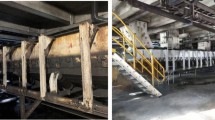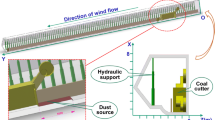Abstract
To solve the problem of excessive dust concentration in the belt transportation roadway of the mine. Numerical simulations were used to study the dust migration in the belt transportation roadway under 1.5 m/s ventilation conditions. The simulation results show the process of dust ejection from the inflow chute to contamination of the whole belt transportation roadway, and the spatial distribution of dust velocity. A comprehensive dust reduction scheme of “central suppression and bilateral splitting” was designed according to the dust distribution, with simultaneous control of the infeed chute and the roadway. In practical application, pneumatic spraying greatly reduces the amount of dust in the guide chute. The misting screen has a significant effect on dust collection and segregation. The solution effectively controls the dust in the space of 20 m on both sides of the transfer point, and the dust removal efficiency reaches more than 90%.













Similar content being viewed by others
Data availability
Some or all data, models, or code generated or used during the study are available from the corresponding author by request.
References
Bhamjee M, Nurick A, Madyira DM (2013) An experimentally validated mathematical and CFD model of a supply air window: Forced and natural flow. Energy Build 57:289–330
Camelli FE, Byrne G, Lohner R (2014) Modeling subway air flflow using CFD. Tunn Undergr Space Technol 43:20–31
Chen YS, Hsiau SS, Lai SC (2009) Filtration of dust particulates with a moving granular bed filter. J Hazard Mater 171:987–994
Cheng WM, Zhang QT, Liu ZS (2011) Research and practices on numerical simulation of dust field and dust collection system in full mechanized mine roadway heading face, Coal Sci. Technol 39:39–44
Geng F, Gui CG, Wang YC (2019) Dust distribution and control in a coal roadway driven by an air curtain system: A numerical study, Process Saf. Environ Protect 121:32–42
Gerlich V, Sulovská K, Zálešák M (2013) COMSOL Multiphysics validation as simulation software for heat transfer calculation in buildings: building simulation software validation. Measurement 46(6):2003–2012. https://doi.org/10.1016/j.measurement.2013.02.020
Gissler C, Band S, Peer A, Ihmsen M, Teschner M (2017) Generalized drag force for particle-based simulations. Comput Graph 69:1–11. https://doi.org/10.1016/j.cag.2017.09.002
Hamid RN, Hassan BT (2013) Development of boundary transfer method in simulation of gas-solid turbulent flflow of a riser. Appl Math Model 37(4):2445–2459
Hu SY, Feng GR, Ren XY (2016) Numerical study of gas-solid two-phase flow in a coal roadway after blasting. Adv Powder Technol 27:1607–1617
ISO (2011) Environmental management. material flow cost accounting. General Framework. International Organization for Standardization (ISO). Geneva, Switzerland (pp 64–78)
Launder BE, Spalding DB (1974) The numerical computation of turbulent flflows. Comput Methods Appl Mech Eng 3(2):269–289
Liu Q, Nie W, Hua Y (2019) A study on the dust control effect of the dust extraction system in TBM construction tunnels based on CFD computer simulation technology. Adv Powder Technol 30(10):2059–2075
Mo ZW, Liu CH (2018) Wind tunnel measurements of pollutant plume dispersion over hypothetical urban areas. Build Environ 132:357–366
Nazif HR, Tabrizi HB (2013) Development of boundary transfer method in simulation of gas-solid turbulent flow of a riser. Appl Math Model 37:2445–2459
Nie W, Wei W, Cai P (2018) Simulation experiments on the controllability of dust diffusion by means of multi-radial vortex airflow. Adv Powder Technol 29(3):835–847
Pak SI, Chang KS (2006) Performance estimation of a Venturi scrubber using a computational model for capturing dust particles with liquid spray. J Hazard Mater 138:560–573
Ren T, Wang Z, Cooper G (2014) CFD modelling of ventilation and dust flflow behavior above an underground bin and the design of an innovative dust mitigation system. Tunn Undergr Space Technol 41:241–254
Wang YP, Jiang ZA, Chen JS (2019) Study of high-pressure air curtain and combined dedusting of gas water spray in multilevel ore pass based on CFD-DEM. Adv Powder Technol 30:1789–1804
Wei W, Mandin C, Blanchard O (2017) Predicting the gas-phase concentration of semi-volatile organic compounds from airborne particles: Application to a French nationwide survey. Sci Total Environ 576:319–325
Xu G, Luxbacher KD, Ragab S (2016) Computational fluid dynamics applied to mining engineering: a review. Int J Min Reclam Environ 31:251–275
Yin WJ, Zhou G, Gao DH (2019) Simulation analysis and engineering application of distribution characteristics about multi-stage atomization field for cutting dust in fully mechanized mining face. Adv Powder Technol 30:2600–2615
Yu H, Cheng W, Peng H, Xie Y (2018) An investigation of the nozzle’s atomization dust suppression rules in a fully-mechanized excavation face based on the airflow-droplet-dust three-phase coupling model. Adv Powder Technol 29(4):941–956
Zeng ZX, Zhou LX, Zhang J (2005) A two-scale second-order moment two-phase turbulence model for simulating dense gas-particle flows, Acta Mech. Sin 21:425–429
Zhang T, Jing D (2020) Numerical simulation of the dimensional transformation of atomization in a supersonic aerodynamic atomization dust-removing nozzle based on transonic speed compressible flow. Int J Coal Sci Technol 7:1–14
Zhang T, Jing D, Shaocheng (2020) Supersonic antigravity aerodynamic atomization dusting nozzle based on the Laval nozzle and probe jet. J Braz Soc Mech Sci Eng 42:126–135
Zhou G, Zhang QT, Hu YY (2020) Dust removal effect of negatively-pressured spraying collector for advancing support in fully mechanized coal mining face: Numerical simulation and engineering application. Tunn Undergr Space Technol 95:103149
Acknowledgements
The authors are grateful to all research staff that contributed to the data collection required for this study.
Funding
This work was funded by the Liaoning Natural Science Foundation General Program Project (Project No. 2020-MS-304); National Natural Science Foundation Youth Fund Project (Project No. 51704146); Liaoning Technical University Discipline Innovation Team Project (project number LNTU20TD-18).
Author information
Authors and Affiliations
Contributions
Deji Jing, Mingxing Ma: conceptualization, methodology, formal analysis, investigation, resources, data curation, writing—original draft, writing—review and editing, and visualization. Shaocheng Ge, Tian Zhang: con- ceptualization, methodology, formal analysis, investigation, resources, data curation, writing—original draft, writing—review and editing, visualization, supervision, and project administration. Xiangxi Meng: validation, investigation, writing—review and editing, and visualization. Shuaishuai Ren: investigation and visualization. All authors read and approved the final manuscript.
Corresponding author
Ethics declarations
Ethics approval and consent to participate
The study did not address ethical issues.
Consent for publication
Not applicable.
Competing interests
The authors declare that they have no competing interests.
Additional information
Responsible Editor: Shimin Liu
Publisher's note
Springer Nature remains neutral with regard to jurisdictional claims in published maps and institutional affiliations.
Rights and permissions
Springer Nature or its licensor (e.g. a society or other partner) holds exclusive rights to this article under a publishing agreement with the author(s) or other rightsholder(s); author self-archiving of the accepted manuscript version of this article is solely governed by the terms of such publishing agreement and applicable law.
About this article
Cite this article
Jing, D., Ma, M., Ge, S. et al. Study on the dust migration law and a spray dust suppression scheme in transportation roadway. Environ Sci Pollut Res 30, 59316–59326 (2023). https://doi.org/10.1007/s11356-023-26716-9
Received:
Accepted:
Published:
Issue Date:
DOI: https://doi.org/10.1007/s11356-023-26716-9




